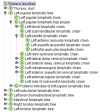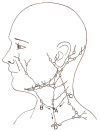Content-specific auditing of a large scale anatomy ontology
- PMID: 19248842
- PMCID: PMC2761215
- DOI: 10.1016/j.jbi.2009.02.006
Content-specific auditing of a large scale anatomy ontology
Abstract
Biomedical ontologies are envisioned to be usable in a range of research and clinical applications. The requirements for such uses include formal consistency, adequacy of coverage, and possibly other domain specific constraints. In this report we describe a case study that illustrates how application specific requirements may be used to identify modeling problems as well as data entry errors in ontology building and evolution. We have begun a project to use the UW Foundational Model of Anatomy (FMA) in a clinical application in radiation therapy planning. This application focuses mainly (but not exclusively) on the representation of the lymphatic system in the FMA, in order to predict the spread of tumor cells to regional metastatic sites. This application requires that the downstream relations associated with lymphatic system components must only be to other lymphatic chains or vessels, must be at the appropriate level of granularity, and that every path through the lymphatic system must terminate at one of the two well known trunks of the lymphatic system. It is possible through a programmable query interface to the FMA to write small programs that systematically audit the FMA for compliance with these constraints. We report on the design of some of these programs, and the results we obtained by applying them to the lymphatic system. The algorithms and approach are generalizable to other network organ systems in the FMA such as arteries and veins. In addition to illustrating exact constraint checking methods, this work illustrates how the details of an application may reflect back a requirement to revise the design of the ontology itself.
Figures



Similar articles
-
Biological Model Development as an Opportunity to Provide Content Auditing for the Foundational Model of Anatomy Ontology.AMIA Annu Symp Proc. 2015 Nov 5;2015:2111-20. eCollection 2015. AMIA Annu Symp Proc. 2015. PMID: 26958311 Free PMC article.
-
From frames to OWL2: Converting the Foundational Model of Anatomy.Artif Intell Med. 2016 May;69:12-21. doi: 10.1016/j.artmed.2016.04.003. Epub 2016 Apr 27. Artif Intell Med. 2016. PMID: 27235801 Free PMC article.
-
The Foundational Model of Anatomy in OWL 2 and its use.Artif Intell Med. 2013 Feb;57(2):119-32. doi: 10.1016/j.artmed.2012.11.002. Epub 2012 Dec 28. Artif Intell Med. 2013. PMID: 23273493
-
The practical impact of ontologies on biomedical informatics.Yearb Med Inform. 2006:124-35. Yearb Med Inform. 2006. PMID: 17051306 Review.
-
The ontology of craniofacial development and malformation for translational craniofacial research.Am J Med Genet C Semin Med Genet. 2013 Nov;163C(4):232-45. doi: 10.1002/ajmg.c.31377. Epub 2013 Oct 4. Am J Med Genet C Semin Med Genet. 2013. PMID: 24124010 Free PMC article. Review.
Cited by
-
An analysis of multi-type relational interactions in FMA using graph motifs with disjointness constraints.AMIA Annu Symp Proc. 2012;2012:1060-9. Epub 2012 Nov 3. AMIA Annu Symp Proc. 2012. PMID: 23304382 Free PMC article.
-
Development and evaluation of an ontology for guiding appropriate antibiotic prescribing.J Biomed Inform. 2012 Feb;45(1):120-8. doi: 10.1016/j.jbi.2011.10.001. Epub 2011 Oct 11. J Biomed Inform. 2012. PMID: 22019377 Free PMC article.
-
Biological Model Development as an Opportunity to Provide Content Auditing for the Foundational Model of Anatomy Ontology.AMIA Annu Symp Proc. 2015 Nov 5;2015:2111-20. eCollection 2015. AMIA Annu Symp Proc. 2015. PMID: 26958311 Free PMC article.
-
The use of semantic distance metrics to support ontology audit.AMIA Annu Symp Proc. 2010 Nov 13;2010:842-6. AMIA Annu Symp Proc. 2010. PMID: 21347097 Free PMC article.
References
-
- Robbins KT, Medina JE, Wolfe GT, et al. Standardizing neck dissection terminology. Archives of Otolaryngology – Head and Neck Surgery. 1991;117:601–605. Official report of the Academy's committee for head and neck surgery and oncology. - PubMed
-
- Som PM, Curtin HD, Mancuso A. An imaging-based classification for the cervical nodes designed as an adjunt to recent clinical based nodal classification. Archives of Otolaryngology – Head and Neck Surgery. 1999 April;125:388–396. - PubMed
Publication types
MeSH terms
Grants and funding
LinkOut - more resources
Full Text Sources
Medical

